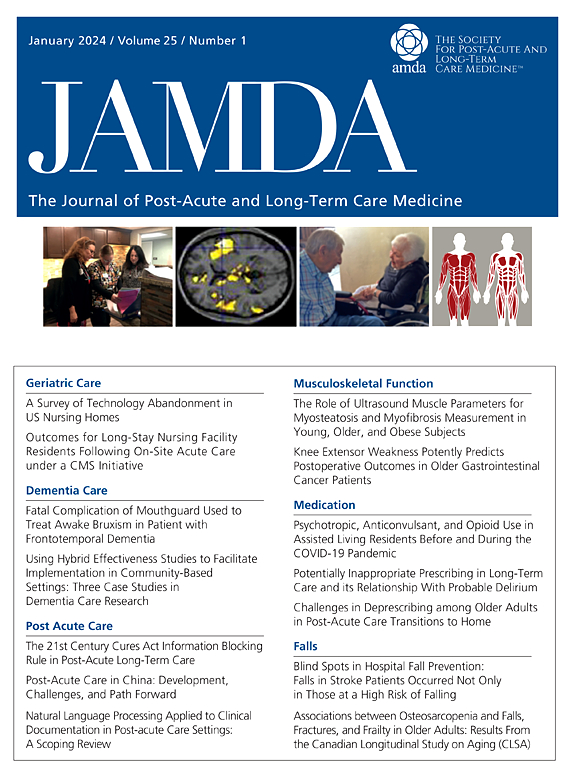Over- and Underuse of Proton Pump Inhibitors in Nursing Homes: A Multisite Longitudinal Cohort Study
IF 4.2
2区 医学
Q2 GERIATRICS & GERONTOLOGY
Journal of the American Medical Directors Association
Pub Date : 2025-02-01
DOI:10.1016/j.jamda.2024.105393
引用次数: 0
Abstract
Objectives
Proton pump inhibitors (PPIs) are used to manage excess stomach acid production and provide gastroprotection from bleeding risk-increasing drugs (BRIDs). We aimed to determine the prevalence of potentially inappropriate PPI use in nursing homes and associated factors.
Design
Longitudinal cohort study using 8 years of electronic data.
Setting and Participants
The study included 6439 permanent residents aged ≥65 years from 34 homes managed by 2 aged care providers in New South Wales.
Method
Continuous PPI use (>12 weeks) in the absence of long-term BRID (>30 days) use was deemed inappropriate overuse whereas long-term BRID use without concomitant PPI for gastroprotection was classified as inappropriate underuse. Binary logistic regression was used to determine factors associated with PPI overuse.
Results
Fifty-four percent of residents (n = 3478) received a PPI, with a median duration of 46 weeks, whereas 58.5% (n = 3770) were long-term BRID users. Four of 5 PPI users (83.6%, n = 2906) used PPIs for >12 weeks, and after accounting for BRID use, the prevalence of inappropriate PPI overuse was 27.1% (n = 944). PPI overuse was 4 times more likely in residents in provider A compared with residents in provider B [odds ratio (OR) 4.08, 95% CI 2.73–6.09]. The prevalence of PPI underuse was 38.5% (n = 1452).
Conclusions and Implications
One in 4 PPI users exceeded the clinically recommended duration, whereas 2 in 5 long-term BRID users did not receive a PPI for gastroprotection. There is a pressing need for tailored interventions, such as medication reviews and deprescribing initiatives, to improve PPI prescribing.
质子泵抑制剂在养老院的过度和不足使用:一项多地点纵向队列研究。
目的:质子泵抑制剂(PPIs)用于控制过量胃酸的产生,并提供胃保护,免受出血风险增加药物(BRIDs)的影响。我们的目的是确定疗养院中潜在的不适当PPI使用的流行程度和相关因素。设计:使用8年电子数据的纵向队列研究。环境和参与者:该研究包括来自新南威尔士州由2名老年护理提供者管理的34个家庭的6439名年龄≥65岁的永久居民。方法:在没有长期BRID(>30天)的情况下,持续使用PPI(>12周)被认为是不适当的过度使用,而长期BRID使用而不同时使用PPI用于胃保护被认为是不适当的使用不足。采用二元逻辑回归确定与PPI过度使用相关的因素。结果:54%的居民(n = 3478)接受了PPI,中位持续时间为46周,而58.5%的居民(n = 3770)是长期BRID使用者。5名PPI使用者中有4名(83.6%,n = 2906)使用PPI长达10至12周,在考虑BRID使用后,不适当PPI过度使用的患病率为27.1% (n = 944)。提供者A的居民PPI过度使用的可能性是提供者B的4倍[比值比(OR) 4.08, 95% CI 2.73-6.09]。PPI未充分使用的患病率为38.5% (n = 1452)。结论和意义:1 / 4的PPI使用者超过了临床推荐的持续时间,而2 / 5的长期BRID使用者没有接受PPI来保护胃。迫切需要量身定制的干预措施,如药物审查和处方减少倡议,以改善PPI处方。
本文章由计算机程序翻译,如有差异,请以英文原文为准。
求助全文
约1分钟内获得全文
求助全文
来源期刊
CiteScore
11.10
自引率
6.60%
发文量
472
审稿时长
44 days
期刊介绍:
JAMDA, the official journal of AMDA - The Society for Post-Acute and Long-Term Care Medicine, is a leading peer-reviewed publication that offers practical information and research geared towards healthcare professionals in the post-acute and long-term care fields. It is also a valuable resource for policy-makers, organizational leaders, educators, and advocates.
The journal provides essential information for various healthcare professionals such as medical directors, attending physicians, nurses, consultant pharmacists, geriatric psychiatrists, nurse practitioners, physician assistants, physical and occupational therapists, social workers, and others involved in providing, overseeing, and promoting quality

 求助内容:
求助内容: 应助结果提醒方式:
应助结果提醒方式:


